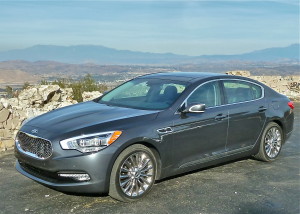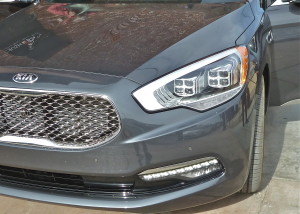K900 Gives Kia a Luxury ‘Multi-Vitamin’
Filed under: Equinox, Autos
By John Gilbert
To the uninformed, K900 might sound like the latest super-vitamin, capable of doing mighty things for your well-being and overall health. In a way, it is that for Kia, because the K900 is Kia’s all-out luxury sedan, powering Kia to rise to a new dimension in automotives.
Skeptics might say that Kia has become known for building strong and inexpensive economy cars, so what are they thinking building a large sedan to compete in the all-out luxury car segment? “We didn’t build the K900 just to serve the market,” said Orth Hedrick, Kia’s vice president of product planning. “This car is designed to change the perception of Kia.
“We had four points we focused on — design, luxury, performance, and technology. In design, we think we hve a modern, timeless look that has a presence.
“For luxury, we have an elegant version of the signature grille and 16-element LED headlights on the outside, and a new definition of what a luxury interior has to be, with modern, sophisticated materials and every touch point making you think luxury and sophistication. It took us three or four years to find a source for the Nappa leather hides from South America that were exactly what we wanted, and the natural wood accents complement it.
“Performance comes from the platform with a stance that can only be gotten by rear-wheel drive,” Hedrick added. “We’ve got 52 percent of the weight on the front and 48 percent on the rear, with a solid structure.”
Of course, the 5.0 V8 is a key element of the performance, with 429 horsepower and 376 foot-pounds of torque, running through an 8-speed automatic that Kia has tweaked for quicker shifting, up and down.
Technology is evident throughout the exterior styling and mechanical features, but blends with luxury that surrounds occupants on the inside. Seats are encompassing in their support and comfort. The multimedia driver assist has a 9.2-inch screen in the center stack, with adjustable redundant readouts on a heads-up display. The optional Harmon Kardon Lexicon audio system has a 12-channel digital amplifier and 17 speakers. Adaptive lane-finding is a feature on the headlights, which have a unique arrangement with two 4-LED clusters on each side, making 16 separate beams. Read more




 John Gilbert is a lifetime Minnesotan and career journalist, specializing in cars and sports during and since spending 30 years at the Minneapolis Tribune, now the Star Tribune. More recently, he has continued translating the high-tech world of autos and sharing his passionate insights as a freelance writer/photographer/broadcaster. A member of the prestigious North American Car and Truck of the Year jury since 1993. John can be heard Monday-Friday from 9-11am on 610 KDAL(www.kdal610.com) on the "John Gilbert Show," and writes a column in the Duluth Reader.
John Gilbert is a lifetime Minnesotan and career journalist, specializing in cars and sports during and since spending 30 years at the Minneapolis Tribune, now the Star Tribune. More recently, he has continued translating the high-tech world of autos and sharing his passionate insights as a freelance writer/photographer/broadcaster. A member of the prestigious North American Car and Truck of the Year jury since 1993. John can be heard Monday-Friday from 9-11am on 610 KDAL(www.kdal610.com) on the "John Gilbert Show," and writes a column in the Duluth Reader.